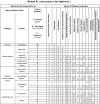Future challenges in the in vitro and in vivo evaluation of biomaterial biocompatibility
- PMID: 27047672
- PMCID: PMC4817327
- DOI: 10.1093/rb/rbw001
Future challenges in the in vitro and in vivo evaluation of biomaterial biocompatibility
Abstract
As the science and engineering of biomaterials continues to expand with increased emphasis on the development of nanomaterials and tissue engineering scaffolds, emphasis also must be placed on appropriate and adequate approaches to the in vivo and in vitro evaluation of biomaterial biocompatibility/biological response evaluation. This article presents six topic areas that should be addressed by investigators as they move forward in the development of new systems for regenerative medicine. Most certainly, there are other areas that require attention to detail and a more complete understanding of the strengths and weaknesses of various experimental approaches to biomaterial/biological response evaluation. The small number of issues addressed in this article is only meant to bring to the attention of prospective investigators and authors, the importance of the development of adequate and appropriate evaluation techniques that address the unique features of biomaterials utilized in the development of new medical devices.
Keywords: biomaterials; nanomaterials; tissue engineering.
Figures
Similar articles
-
The summary of the most important cell-biomaterial interactions that need to be considered during in vitro biocompatibility testing of bone scaffolds for tissue engineering applications.Mater Sci Eng C Mater Biol Appl. 2019 Apr;97:1036-1051. doi: 10.1016/j.msec.2019.01.061. Epub 2019 Jan 16. Mater Sci Eng C Mater Biol Appl. 2019. PMID: 30678895 Review.
-
Nanomaterials for Engineering Stem Cell Responses.Adv Healthc Mater. 2015 Aug 5;4(11):1600-27. doi: 10.1002/adhm.201500272. Epub 2015 May 26. Adv Healthc Mater. 2015. PMID: 26010739 Review.
-
Biocompatibility assessment of biomaterials used in orthopedic devices: An overview (Review).Exp Ther Med. 2021 Nov;22(5):1315. doi: 10.3892/etm.2021.10750. Epub 2021 Sep 17. Exp Ther Med. 2021. PMID: 34630669 Free PMC article. Review.
-
Integrative Utilization of Microenvironments, Biomaterials and Computational Techniques for Advanced Tissue Engineering.J Biotechnol. 2015 Oct 20;212:71-89. doi: 10.1016/j.jbiotec.2015.08.005. Epub 2015 Aug 14. J Biotechnol. 2015. PMID: 26281975 Review.
-
On the mechanisms of biocompatibility.Biomaterials. 2008 Jul;29(20):2941-53. doi: 10.1016/j.biomaterials.2008.04.023. Epub 2008 Apr 28. Biomaterials. 2008. PMID: 18440630 Review.
Cited by
-
Characterization of hFOB 1.19 Cell Line for Studying Zn-Based Degradable Metallic Biomaterials.Materials (Basel). 2024 Feb 16;17(4):915. doi: 10.3390/ma17040915. Materials (Basel). 2024. PMID: 38399166 Free PMC article.
-
Bioactive Glasses: Where Are We and Where Are We Going?J Funct Biomater. 2018 Mar 19;9(1):25. doi: 10.3390/jfb9010025. J Funct Biomater. 2018. PMID: 29562680 Free PMC article. Review.
-
Direct monitoring of single-cell response to biomaterials by Raman spectroscopy.J Mater Sci Mater Med. 2021 Dec 4;32(12):148. doi: 10.1007/s10856-021-06624-5. J Mater Sci Mater Med. 2021. PMID: 34862915 Free PMC article.
-
Nanotherapeutics with immunoregulatory functions for the treatment of bacterial infection.Biomater Res. 2023 Jul 22;27(1):73. doi: 10.1186/s40824-023-00405-7. Biomater Res. 2023. PMID: 37481650 Free PMC article. Review.
-
Development of Poly(sorbitol adipate)-g-poly(ethylene glycol) Mono Methyl Ether-Based Hydrogel Matrices for Model Drug Release.Gels. 2023 Dec 23;10(1):17. doi: 10.3390/gels10010017. Gels. 2023. PMID: 38247740 Free PMC article.
References
-
- Oppenheimer BS, Oppenheimer ET, Danishefsky I. Further studies of polymers as carcinogenic agents in animals. Cancer Res 1955;15:333–40. - PubMed
-
- Hester RT, Jr, Ford NF, Gale TP., et al. Measurement of 2,4-toluenediamine in urine and serum samples from women with Meme or Replicon breast implants. Plast Reconstr Surg 1997;100:1291–8. - PubMed
-
- Chan SC, Birdsell DC, Gradeen CY. Detection of toluenediamines in the urine of a patient with polypropylene-covered breast implants. Clin Chem 1991;37:756–8. - PubMed
-
- Chan SC, Birdsell DC, Gradeen CY. Urinary excretion of free toluenediamines in a patient with polyurethane-covered breast implants. Clin Chem 1991;37:2143–5. - PubMed
Publication types
LinkOut - more resources
Full Text Sources
Other Literature Sources
Research Materials


